Assessing Air-Pocket Pressure Peaks During Water Filling Operations Using Dimensionless Equations
Abstract
1. Introduction
2. Materials and Methods
2.1. Dimensionless Variables
2.2. Dimensionless Parameters
2.3. Dimensionless Equations
2.4. Dimensionless Initial and Boundary Conditions
2.4.1. Initial Conditions
- (a)
- Filling column:
- (b)
- Blocking column entrapped air pocket :
2.4.2. Boundary Conditions
- -
- Boundary energy (motor) parameter
- -
- The boundary shape parameter, , which considers the relationship characterising the source of energy. For a pump, for which , is defined as:where and are the steady-state delivery head and flowrate, respectively. For a reservoir, = 0 or, equivalently, .
3. Pressure Surges and Characteristics Parameters
3.1. Parametrization for Slow and Rapid Air-Pocket Pressure Peaks
- Filling-column parameter , Equation (32).
- Two parameters for each blocking column upstream of air pocket , Equation (4): and , defined by Equations (22) and (23).
- One parameter (observe that is included in and ) for each air pocket upstream of air pocket , Equation (34): .
- One parameter standard to all the air pockets: the polytropic coefficient .
- Two parameters characterising the source of energy, and , and one parameter for every reach with no zero slope, , forcing the layout. Geometry constitutes the drawback of an utterly general study. As seen later, considering only the corresponding to the reach where the air pocket descends gives reasonably good accuracy. Thus, as far as boundary and geometric parameters are concerned (parameters not included explicitly in the equations of the system), three parameters are enough for our study: , , and .
- The case of very fast peaks, which is only possible for the first air pocket ( = 1). They are generated by short transients, requiring high sources of energy (say ≥ 5) that, acting violently due to the sudden opening of the delivery valve (Figure 2), must overcome low initial inertia ( → 0). This makes the gravitational effects irrelevant so that has negligible contribution.
- The case of slow peaks is generated after the compression of an air pocket in the range of minutes. They are typical of air pockets far away from the source of energy (i ≥ 2), but also possible for the first air pocket if is small (around ≤ 1.5) or big (significant initial inertia). With being so small, it loses relevance in front of .
- The intermediate pressure peaks, which value both effects, the driving source of energy (, ) and the gravitational effects induced by the profile (), contribute significantly.
3.1.1. Parameters for Fast Air-Pocket Pressure Peaks
3.1.2. Parameters for Slow Air-Pocket Pressure Peaks
3.2. Parametric Analysis
3.2.1. Charts to Determine Fast Air-Pocket Pressure Peaks
3.2.2. Charts to Determine Slow Air-Pocket Pressure Peaks
3.3. Boundary Between Fast and Slow Air-Pocket Pressure Peaks
4. Practical Application
4.1. Numerical Resolution Using the Physical Equations
4.2. Results Employing the Proposed Methodology
5. Discussion
5.1. Comparision
5.2. Classification of Pressure Peaks
6. Conclusions
- (a)
- Fast peaks, which occur at the first air pocket when and are characterised by the system parameter and two boundary parameters and . Geometric contribution can safely be ignored.
- (b)
- Slow peaks are typical of second-to-last air pockets. Slow peaks are mainly influenced by gravitational forces, which must be considered through the single parameter corresponding to the reach where the air pocket under study is descending. This parameter, together with parameter , allow for the estimation of slow peaks.
- (a)
- The intensity and characteristics of the source(s) of energy, , , and .
- (b)
- Parameter , i.e., the air-pocket capacity to store energy related to the inertia of its blocking column.
Author Contributions
Funding
Data Availability Statement
Conflicts of Interest
Abbreviations
| : | cross-sectional cross area (m2): |
| : | pump characteristic constants; |
| : | internal pipe diameter (m); |
| : | constant friction factor (-); |
| : | gravitational acceleration (m/s2); |
| : | atmospheric pressure head (m); |
| : | pump head (m); |
| : | reservoir water level (m); |
| : | air-pocket pressure head (m); |
| : | initial air-pocket pressure head (m); |
| : | maximum air-pocket pressure head (m); |
| : | pressure head scale (m); |
| : | steady-state head (m) (definition of ); |
| : | dimensionless source head (-); |
| : | dimensionless pressure of air pocket (-); |
| Filling-column length (m); | |
| : | initial length of air pocket (m); |
| : | length of blocking column (m): |
| : | length scale or initial length of first air pocket (m); |
| : | length of reach (m); |
| : | dimensionless length of the filling column (m); |
| : | number of entrapped air pockets (-)/polytropic coefficient (-); |
| : | pressure scale (Pa); |
| : | pressure of air pocket (Pa); |
| : | flowrate (m3/s); |
| : | steady-state flow (m3/s); |
| : | time scale (s); |
| : | time for air pocket to reach maximum pressure (s); |
| : | velocity of the filling column (m/s); |
| : | velocity scale (m/s); |
| : | velocity of blocking column (m/s); |
| : | front end location of blocking column (m); |
| : | initial value of (m); |
| : | volume scale (m3); |
| : | the elevation difference between ends of the filling column (m); |
| : | the elevation difference between ends of blocking column (m); |
| : | the dimensionless elevation difference between the end of the filling column (-); |
| : | the dimensionless elevation difference between the end of blocking column (-); |
| : | the ratio between the length of blocking column and air pocket (-); |
| : | dimensionless length of the filling column(-); |
| : | dimensionless length of blocking column (-); |
| : | initial dimensionless length of the filling column (-); |
| : | profile parameter corresponding to reach (-); |
| : | water unit weight (N/m3); |
| : | dimensionless number of air pocket (-); |
| : | scale parameter (-); |
| : | friction parameter (-); |
| : | total friction parameter of blocking column (-); |
| : | inertia parameter (-); |
| : | total inertia parameter of blocking column (-); |
| : | boundary energy (motor) parameter (-); |
| : | longitudinal slope of reach (rad); |
| : | dimensionless time (-); |
| Subscript | |
| : | refers to air pockets and their corresponding blocking columns; |
| : | for profile reaches; |
| Superscripts | |
| : | refers to absolute pressure. |
References
- Liou, C.P.; Hunt, W.A. Filling of Pipelines with Undulating Elevation Profiles. J. Hydraul. Eng. 1996, 122, 534–539. [Google Scholar] [CrossRef]
- Wang, L.; Wang, F.; Karney, B.; Malekpour, A. Numerical Investigation of Rapid Filling in Bypass Pipelines. J. Hydraul. Res. 2017, 55, 647–656. [Google Scholar] [CrossRef]
- Ferreira, J.P.; Ferràs, D.; Covas, D.I.C.; van der Werf, J.A.; Kapelan, Z. Air Entrapment Modelling during Pipe Filling Based on SWMM. J. Hydraul. Res. 2024, 62, 39–57. [Google Scholar] [CrossRef]
- Fuertes-Miquel, V.S.; Coronado-Hernández, O.E.; Mora-Meliá, D.; Iglesias-Rey, P.L. Hydraulic Modeling during Filling and Emptying Processes in Pressurized Pipelines: A Literature Review. Urban Water J. 2019, 16, 299–311. [Google Scholar] [CrossRef]
- Izquierdo, J.; Fuertes, V.S.; Cabrera, E.; Iglesias, P.L.; Garcia-Serra, J. Pipeline Start-up with Entrapped Air. J. Hydraul. Res. 1999, 37, 579–590. [Google Scholar] [CrossRef]
- Zhou, L.; Liu, D.; Karney, B. Investigation of Hydraulic Transients of Two Entrapped Air Pockets in a Water Pipeline. J. Hydraul. Eng. 2013, 139, 949–959. [Google Scholar] [CrossRef]
- Ramezani, L.; Karney, B.; Malekpour, A. Encouraging Effective Air Management in Water Pipelines: A Critical Review. J. Water Resour. Plan Manag 2016, 142, 4016055. [Google Scholar] [CrossRef]
- Ramezani, L.; Karney, B.; Malekpour, A. The Challenge of Air Valves: A Selective Critical Literature Review. J. Water Resour. Plan Manag. 2015, 141, 4015017. [Google Scholar] [CrossRef]
- American Water Works Association (AWWA). Air-Release, Air/Vacuum, and Combination Air Valves: M51; American Water Works Association: Denver, CO, USA, 2001; Volume 51. [Google Scholar]
- Abreu, J.; Cabrera, E.; Izquierdo, J.; García-Serra, J. Flow Modeling in Pressurized Systems Revisited. J. Hydraul. Eng. 1999, 125, 1154–1169. [Google Scholar] [CrossRef]
- Fuertes-Miquel, V.S.; López-Jiménez, P.A.; Martínez-Solano, F.J.; López-Patiño, G. Numerical Modelling of Pipelines with Air Pockets and Air Valves. Can. J. Civ. Eng. 2016, 43, 1052–1061. [Google Scholar] [CrossRef]
- Martin, C.S. Entrapped Air in Pipelines. In Proceedings of the 2nd International Conference on Pressure Surges, London UK, 22–24 September 1976; British Hydromechanics Research Assoc.: Cranfield, UK, 1976. [Google Scholar]
- Tullis, J.; Watkins, R. Pipe Collapse Caused by a Pipe Rupture—A Case Study. In Hydraulic Transients with Water Column Separation; 9th and Last Round Table of the IAHR Group: Valencia, Spain, 1991. [Google Scholar]
- de Almeida, A.B.; Koelle, E. Fluid Transients in Pipe Networks; Computational Mechanics Publications; Springer: Berlin/Heidelberg, Germany, 1992. [Google Scholar]
- Zhou, L.; Liu, D.; Karney, B.; Zhang, Q. Influence of Entrapped Air Pockets on Hydraulic Transients in Water Pipelines. J. Hydraul. Eng. 2011, 137, 1686–1692. [Google Scholar] [CrossRef]
- Coronado-Hernández, Ó.E.; Besharat, M.; Fuertes-Miquel, V.S.; Ramos, H.M. Effect of a Commercial Air Valve on the Rapid Filling of a Single Pipeline: A Numerical and Experimental Analysis. Water 2019, 11, 1814. [Google Scholar] [CrossRef]
- Zhou, L.; Pan, T.; Wang, H.; Liu, D.; Wang, P. Rapid Air Expulsion through an Orifice in a Vertical Water Pipe. J. Hydraul. Res. 2019, 57, 307–317. [Google Scholar] [CrossRef]
- Fang, H.; Zhou, L.; Cao, Y.; Cai, F.; Liu, D. 3D CFD Simulations of Air-Water Interaction in T-Junction Pipes of Urban Stormwater Drainage System. Urban Water J. 2022, 19, 74–86. [Google Scholar] [CrossRef]
- He, J.; Hou, Q.; Lian, J.; Tijsseling, A.S.; Bozkus, Z.; Laanearu, J.; Lin, L. Three-Dimensional CFD Analysis of Liquid Slug Acceleration and Impact in a Voided Pipeline with End Orifice. Eng. Appl. Comput. Fluid Mech. 2022, 16, 1444–1463. [Google Scholar] [CrossRef]
- Martins, N.M.C.; Delgado, J.N.; Ramos, H.M.; Covas, D.I.C. Maximum Transient Pressures in a Rapidly Filling Pipeline with Entrapped Air Using a CFD Model. J. Hydraul. Res. 2017, 55, 506–519. [Google Scholar] [CrossRef]
- Memon, Q.A.; Al Ahmad, M.; Pecht, M. Quantum Computing: Navigating the Future of Computation, Challenges, and Technological Breakthroughs. Quantum Rep. 2024, 6, 627–663. [Google Scholar] [CrossRef]
- Zhou, L.; Lu, Y.; Karney, B.; Wu, G.; Elong, A.; Huang, K. Energy Dissipation in a Rapid Filling Vertical Pipe with Trapped Air. J. Hydraul. Res. 2023, 61, 120–132. [Google Scholar] [CrossRef]
- Malekpour, A.; Shahroodi, A. What Is a Safe Filling Velocity in Water and Wastewater Pipelines? In Pipelines 2023; ASCE: Reston, VA, USA, 2023; pp. 301–312. [Google Scholar] [CrossRef]
- Fuertes-Miquel, V.S. Hydraulic Transients with Entrapped Air Pockets. Ph.D. Thesis, Polytechnic University of Valencia, Spain, Valencia, 2001. [Google Scholar]
- Fuertes-Miquel, V.S.; Coronado-Hernández, O.E.; Arrieta-Pastrana, A. Effects of Expelled Air during Filling Operations with Blocking Columns in Water Pipelines of Undulating Profiles. Fluids 2024, 9, 212. [Google Scholar] [CrossRef]

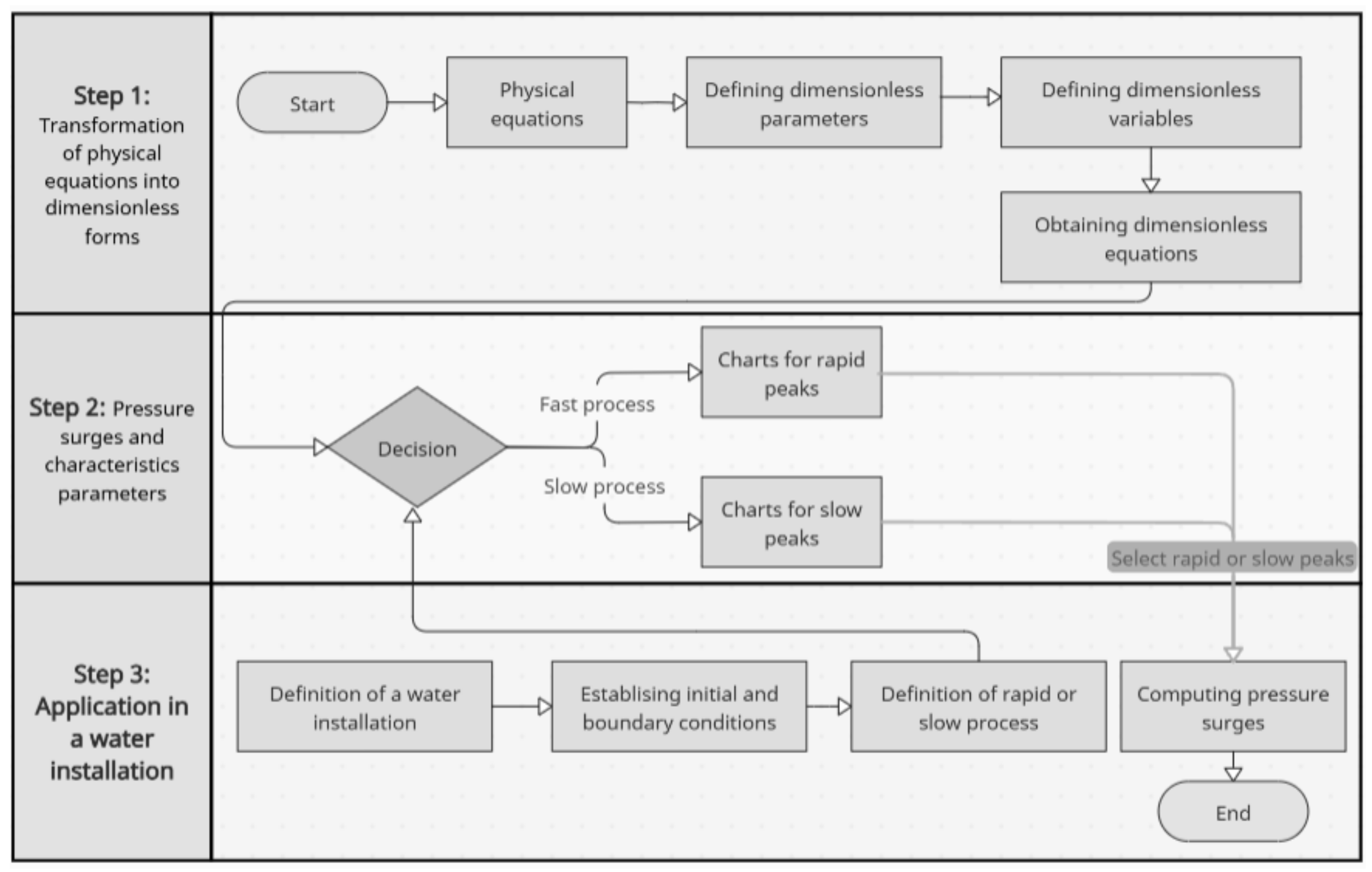
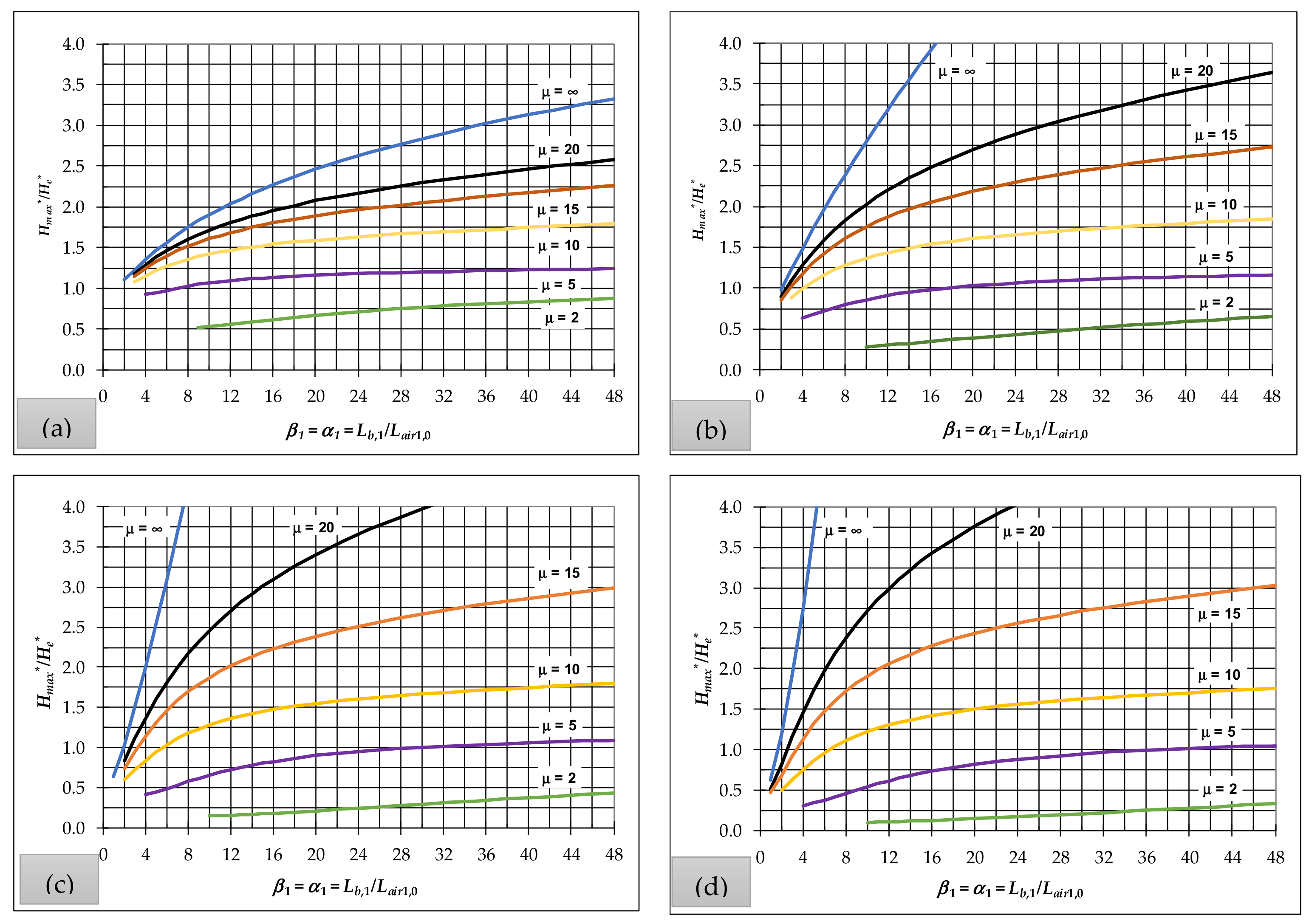
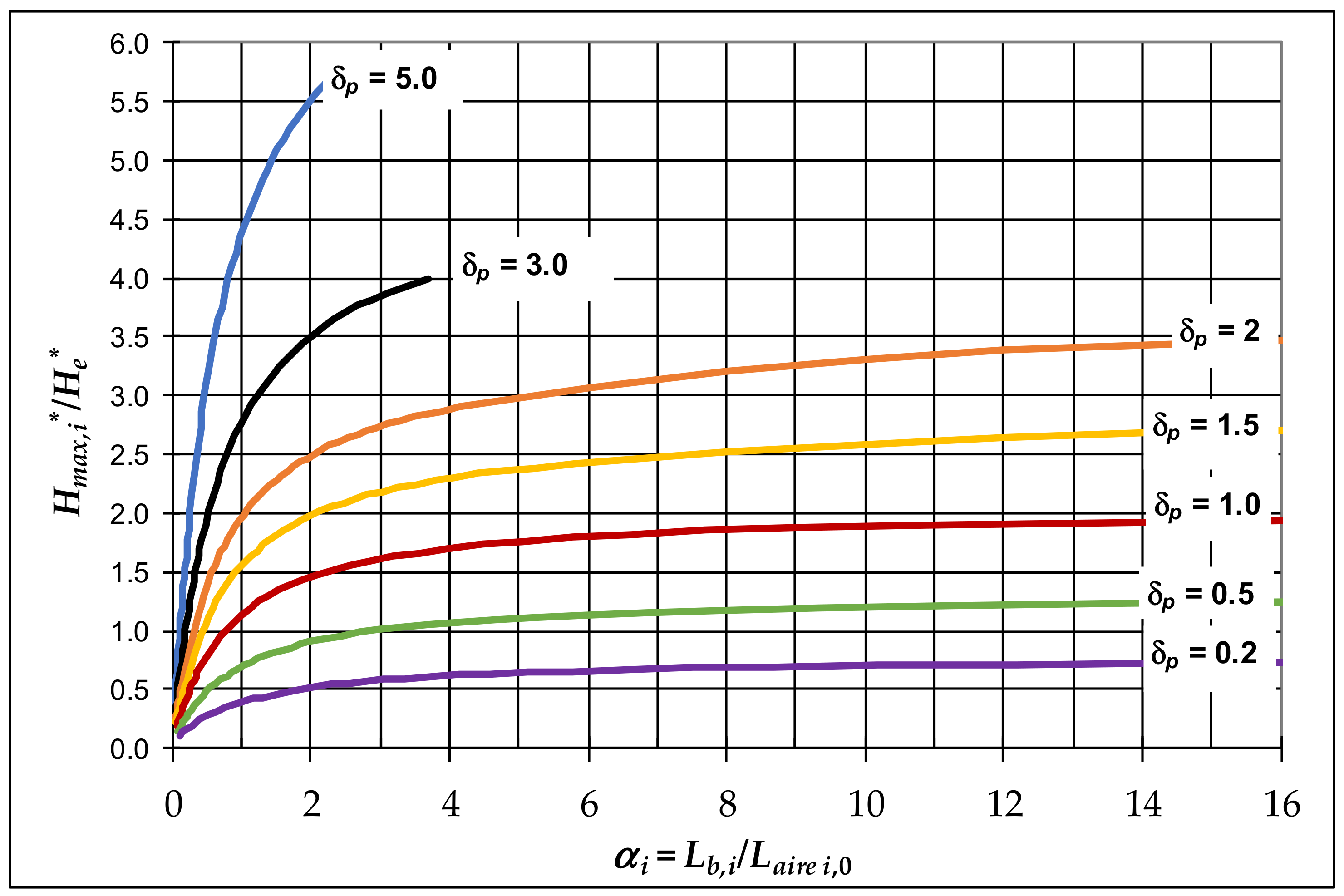
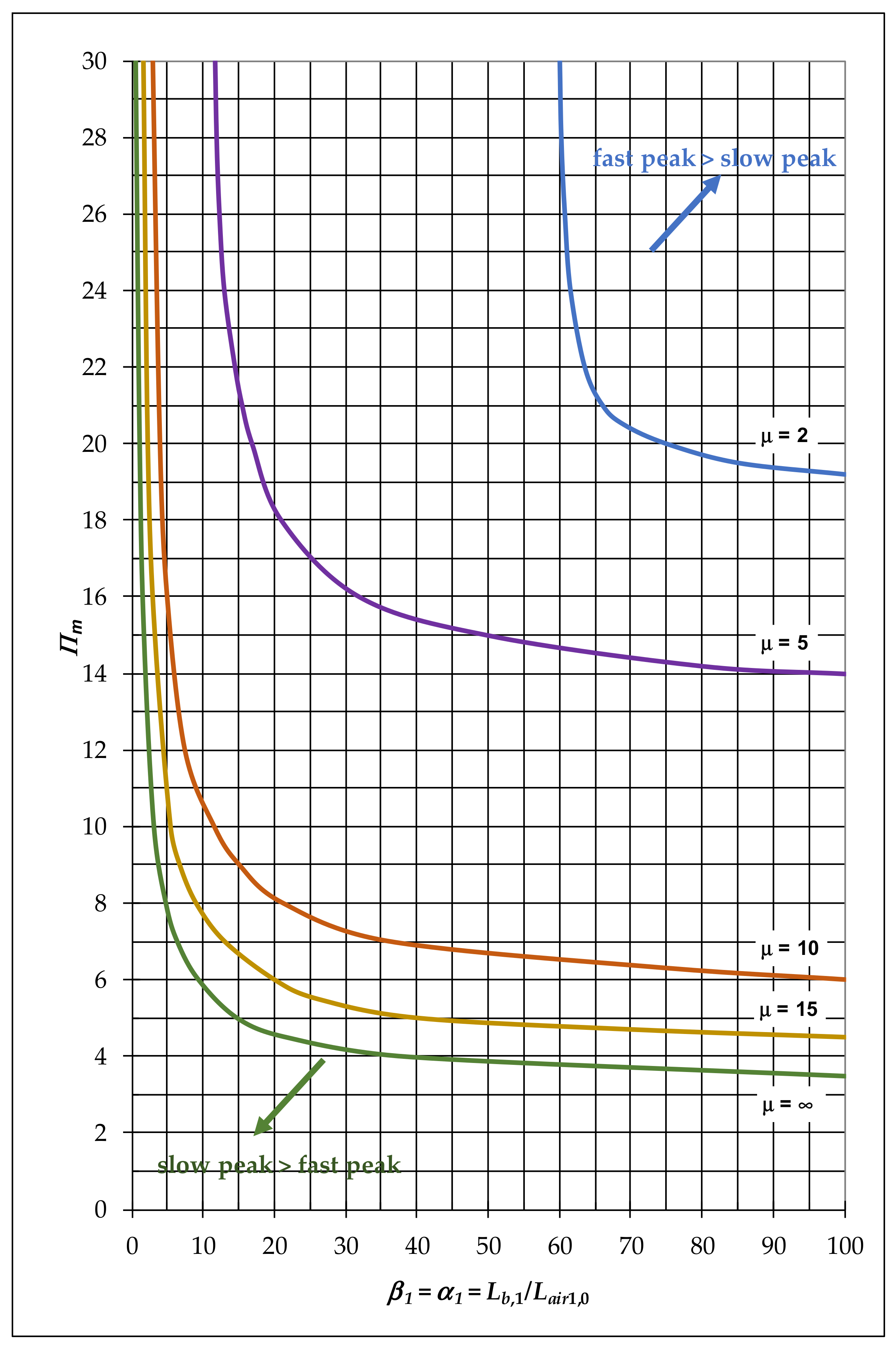

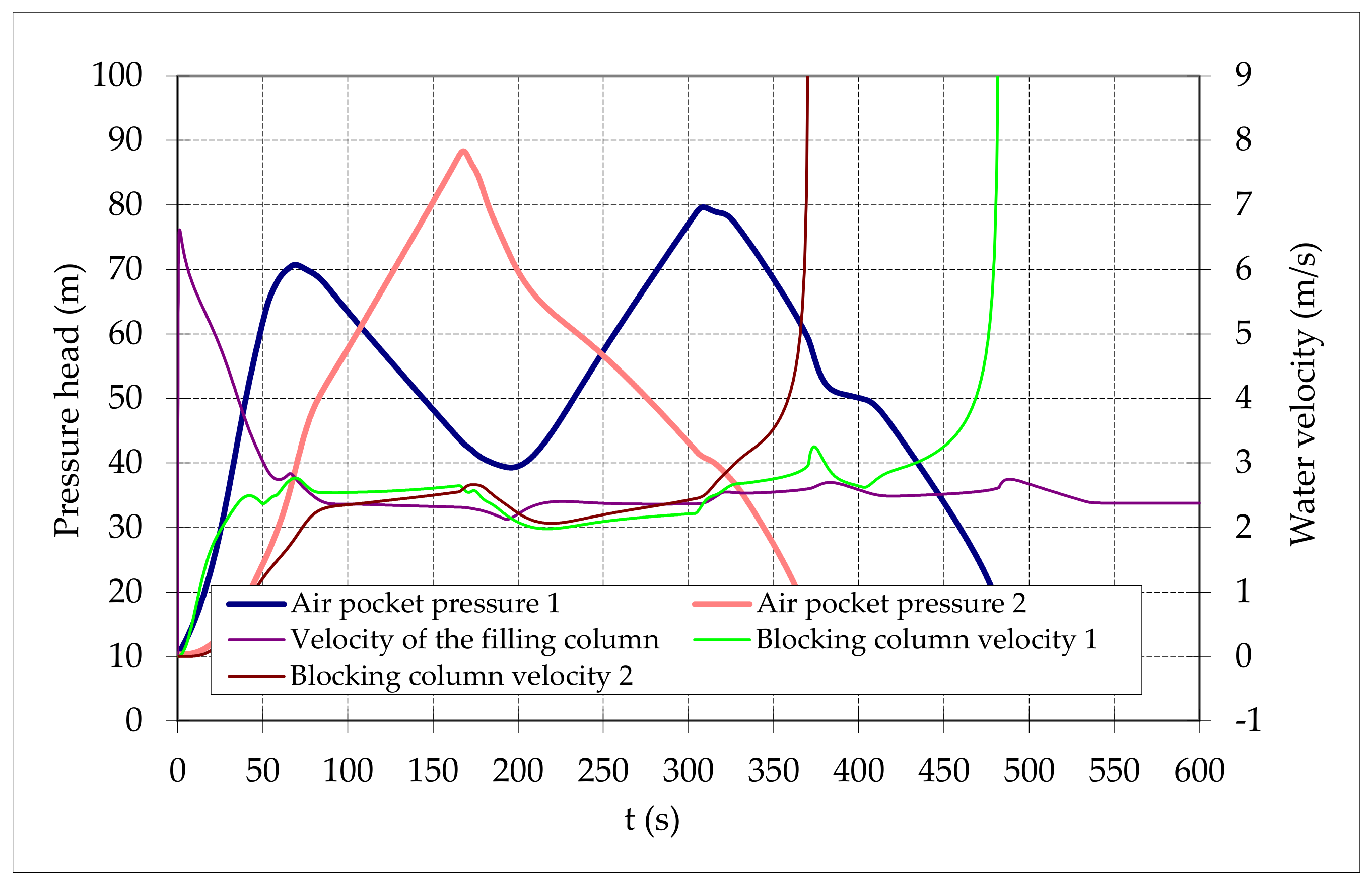
| Dimensionless Variable | Variable Scale |
|---|---|
| Pressure head: | |
| Air-pocket pressure head : | |
| Filling-column velocity: | |
| Blocking-column velocity : | |
| Filling-column length: | |
| Position of a blocking column : | |
| Gravity term of the filling column: | Equation (11) |
| Gravity term of a blocking column : | |
| Air-pocket volume : | |
| Time: | |
| Parameter | Equation |
|---|---|
| Inertial scale | |
| whose value tends to 2 for powerful energy sources . The energy parameter is yielding by . | |
| Friction scale | |
| Whose value tends to be the Martin parameter [12] if ; that is, when the energy parameter is , it is big. | |
| Parameters of water columns | (a) Blocking column : (b) Filling column: (c) Filling column (initial): |
| Original Equation * | Dimensionless Equation |
|---|---|
| Filling Column (2 Equations) | |
| 1.- Rigid model equation for the filling column | |
| 2.- Water–air interface position for the filling column | |
| Blocking Columns/Air Pockets ( equations) | |
| 3.- Rigid model equation for blocking column | |
| Where for the last blocking column , must be replaced | |
| 4.- Entrapped air pocket | |
| 5.- Water–air interface position for the blocking column | |
| being for the first trapped air pocket | |
| Variable | Value | Time |
|---|---|---|
| Air-pocket pressure 1 | ||
| Air-pocket pressure 2 | ||
| Maximum velocity of the filling column | ||
| Maximum velocity of blocking column 1 |
| Air Pocket | Dimensionless Parameters | (m) | |
|---|---|---|---|
| 1 | 4.9 | 75.0 | |
| 2 | 5.5 | 84.0 | |
| Air Pocket | (m) | Discrepancy (%) | |
|---|---|---|---|
| Proposed Methodology | Physical Equations | ||
| 1 | 75.0 | 70.7 | 6.08 |
| 2 | 84.0 | 88.3 | 4.90 |
Disclaimer/Publisher’s Note: The statements, opinions and data contained in all publications are solely those of the individual author(s) and contributor(s) and not of MDPI and/or the editor(s). MDPI and/or the editor(s) disclaim responsibility for any injury to people or property resulting from any ideas, methods, instructions or products referred to in the content. |
© 2025 by the authors. Licensee MDPI, Basel, Switzerland. This article is an open access article distributed under the terms and conditions of the Creative Commons Attribution (CC BY) license (https://creativecommons.org/licenses/by/4.0/).
Share and Cite
Fuertes-Miquel, V.S.; Coronado-Hernández, O.E.; Sánchez-Romero, F.J.; Saba, M.; Pérez-Sánchez, M. Assessing Air-Pocket Pressure Peaks During Water Filling Operations Using Dimensionless Equations. Mathematics 2025, 13, 267. https://doi.org/10.3390/math13020267
Fuertes-Miquel VS, Coronado-Hernández OE, Sánchez-Romero FJ, Saba M, Pérez-Sánchez M. Assessing Air-Pocket Pressure Peaks During Water Filling Operations Using Dimensionless Equations. Mathematics. 2025; 13(2):267. https://doi.org/10.3390/math13020267
Chicago/Turabian StyleFuertes-Miquel, Vicente S., Oscar E. Coronado-Hernández, Francisco J. Sánchez-Romero, Manuel Saba, and Modesto Pérez-Sánchez. 2025. "Assessing Air-Pocket Pressure Peaks During Water Filling Operations Using Dimensionless Equations" Mathematics 13, no. 2: 267. https://doi.org/10.3390/math13020267
APA StyleFuertes-Miquel, V. S., Coronado-Hernández, O. E., Sánchez-Romero, F. J., Saba, M., & Pérez-Sánchez, M. (2025). Assessing Air-Pocket Pressure Peaks During Water Filling Operations Using Dimensionless Equations. Mathematics, 13(2), 267. https://doi.org/10.3390/math13020267














